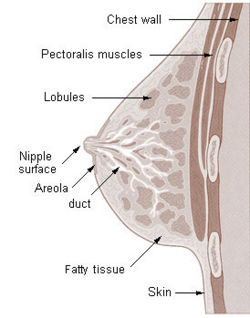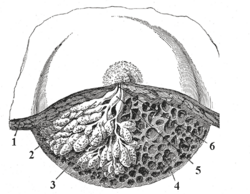Mammary gland
| Mammary gland | |
|---|---|
 |
|
| Cross section of the breast of a human female. | |
 |
|
| Dissection of a lactating breast. 1 - Fat 2 - Lactiferous duct/lobule 3 - Lobule 4 - Connective tissue 5 - Sinus of lactiferous duct 6 - Lactiferous duct |
|
| Latin | glandula mammaria |
| Gray's | subject #271 1267 |
Mammary glands are the organs that, in mammals, produce milk for the sustenance of the young. These exocrine glands are enlarged and modified sweat glands and give mammals their name. The mammary glands of domestic mammals containing more than two breasts are called dugs.
Contents |
Humans
Structure
The basic components of the mammary gland are the alveoli (hollow cavities, a few millimetres large) lined with milk-secreting cuboidal cells and surrounded by myoepithelial cells. These alveoli join up to form groups known as lobules, and each lobule has a lactiferous duct that drains into openings in the nipple. The myoepithelial cells can contract under the stimulation of oxytocin thereby excreting the milk from glands through the lactiferous ducts toward the nipple, where it collects in sinuses of the ducts. As the infant begins to suck, the hormonally (oxytocin) mediated "let down reflex" ensues and the mother's milk is secreted into – not sucked from the gland by – the baby's mouth.
All the milk-secreting tissue leading to a single lactiferous duct is called a "simple mammary gland"; a "complex mammary gland" is all the simple mammary glands serving one nipple. Humans normally have two complex mammary glands, one in each breast, and each complex mammary gland consists of 10–20 simple glands. The presence of more than two nipples is known as polythelia and the presence of more than two complex mammary glands as polymastia.
Development and hormonal control
Mammary glands exist in both sexes, but are rudimentary until puberty when, in females, they begin to develop in response to ovarian hormones. Estrogen promotes formation, whereas testosterone inhibits it.
At the time of birth, the baby has lactiferous ducts but no alveoli. Little branching occurs before puberty when ovarian estrogens stimulate branching differentiation of the ducts into spherical masses of cells that will become alveoli. True secretory alveoli only develop in pregnancy, where rising levels of estrogen and progesterone cause further branching and differentiation of the duct cells, together with an increase in adipose tissue and a richer blood flow.
Colostrum is secreted in late pregnancy and for the first few days after giving birth. True milk secretion (lactation) begins a few days later due to a reduction in circulating progesterone and the presence of the hormone prolactin. The suckling of the baby causes the release of the hormone oxytocin which stimulates contraction of the myoepithelial cells.
Breast cancer
As described above, the cells of mammary glands can easily be induced to grow and multiply by hormones. If this growth runs out of control, cancer results. Almost all instances of breast cancer originate in the lobules or ducts of the mammary glands.
Other mammals
The number and positioning of complex and simple mammary glands varies widely in different mammals. The nipples and glands can occur anywhere along the two milk lines, two roughly-parallel lines along the ventral aspect of the body. In general most mammals develop mammary glands in pairs along these lines, with a number approximating the number of young typically birthed at a time. The number of nipples varies from 2 (in most primates) to 16 (in pigs). The Virginia Opossum has 13, one of the few mammals with an odd number[1][2]. The following table lists the number and position of glands normally found in a range of mammals:
| Species [3] | Anterior (thoracic) |
Intermediate (abdominal) |
Posterior (Inguinal) |
Total |
|---|---|---|---|---|
| Goat, sheep, horse guinea pig |
0 | 0 | 2 | 2 |
| Cattle | 0 | 0 | 4 | 4 |
| Cat | 2 | 2 | 2 | 6 |
| Dog [4] | 4 | 2 | 2 or 4 | 8 or 10 |
| Mouse | 6 | 0 | 4 | 10 |
| Rat | 6 | 2 | 4 | 12 |
| Pig | 6 | 6 | 4 | 16 |
| Elephants, primates | 2 | 0 | 0 | 2 |
Male mammals typically have rudimentary mammary glands and nipples, with a few exceptions: male mice don't have nipples, and male horses lack nipples and mammary glands. The male Dyak fruit bat has lactating mammary glands;[5] male lactation occurs infrequently in some species, including humans.
Mammary glands are true protein factories, and several companies have constructed transgenic animals, mainly goats and cows, in order to produce proteins for pharmaceutical use. Complex glycoproteins such as monoclonal antibodies or antithrombin cannot be produced by genetically engineered bacteria, and the production in live mammals is much cheaper than the use of mammalian cell cultures.
Evolution
It is believed that the mammary gland is a transformed sweat gland, more closely related to Apocrine sweat glands. There are many theories of how they evolved, but since they do not fossilize well, supporting such theories presents a major difficulty for the researcher. One theory proposes that mammary glands evolved from glands that were used to keep the eggs of early mammals moist.[1]
Gallery
See also
- Breastfeeding
- Mammary tumor
- Gynecomastia
- Teat
- Udder
- Witch's milk
References
- ↑ With the Wild Things - Transcripts
- ↑ Raising Orphaned Baby Opossums
- ↑ Merle Cunningham, Animal Science and Industry ISBN 9780130462565
- ↑ Dog breeds vary in the number of mammary glands: larger breeds tend to have 5 pairs, smaller breeds have 4 pairs.
- ↑ Francis, Charles M.; Anthony, Edythe L. P.; Brunton, Jennifer A.; Kunz, Thomas H. (1994-02-24). "Lactation in male fruit bats". Nature (Nature Publishing Group) 367: 691–692. doi:. http://www.nature.com/nature/journal/v367/n6465/abs/367691a0.html. Retrieved on 2008-05-14.
External links
- Comparative Mammary Gland Anatomy by W. L. Hurley
- On the anatomy of the breast by Sir Astley Paston Cooper (1840). Numerous drawings, in the public domain.
- mammary+gland at eMedicine Dictionary
|
|||||||||||||||||||||||||||||||||||||||